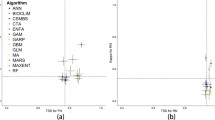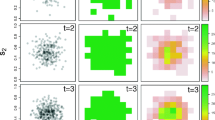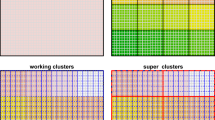Abstract
The indicator value and ecological amplitude of a species with respect to a quantitative environmental variable can be estimated from data on species occurrence and environment. A simple weighted averaging (WA) method for estimating these parameters is compared by simulation with the more elaborate method of Gaussian logistic regression (GLR), a form of the generalized linear model which fits a Gaussian-like species response curve to presence-absence data. The indicator value and the ecological amplitude are expressed by two parameters of this curve, termed the optimum and the tolerance, respectively. When a species is rare and has a narrow ecological amplitude — or when the distribution of quadrats along the environmental variable is reasonably even over the species' range, and the number of quadrats is small — then WA is shown to approach GLR in efficiency. Otherwise WA may give misleading results. GLR is therefore preferred as a practical method for summarizing species' distributions along environmental gradients. Formulas are given to calculate species optima and tolerances (with their standard errors), and a confidence interval for the optimum from the GLR output of standard statistical packages.
Similar content being viewed by others
References
Alvey, N. G., et al., 1977. GENSTAT: a general statistical program. Rothamsted Experimental Station, Harpenden, England.
Ashby, E., 1936. Statistical ecology. Bot. Rev. 2: 221–235.
Austin, M. P., 1980. Searching for a model for use in vegetation analysis. Vegetatio 42: 11–21.
Austin, M. P., Cunningham, R. B. & Fleming, P. M., 1984. New approaches to direct gradient analysis using environmental scalars and statistical curve-fitting procedures. Vegetatio 55: 11–27.
Baker, R. J. & Nelder, J. A., 1978. The GLIM System, Release 3. Numerical Algorithms Groups, Oxford.
Barr, A. J., et al., 1982. SAS User's Guide: Statistics, 1982 edition. SAS Institue Inc., Cary, 584 pp.
Breslow, N. E. & Day, N. E., 1980. Statistical Methods in Cancer Research. Vol. 1. The Analysis of Case-Control Studies. IARC Scientific Publication, nr. 32, Lyon, 338 pp.
Cox, D. R., 1970. The Analysis of Binary Data. Methuen, London, 142 pp.
Dixon, W. J., 1981. BMDP Statistical Software, University of California Press, Berkeley, 726 pp.
Dobson, A. J., 1983. An Introduction to Statistical Modelling. Chapman & Hall, London, 125 pp.
Ellenberg, H., 1979. Zeigerwerte der Gefässpflanzen Mitteleuropas. 2nd ed. Scripta Geobotanica 9, Göttingen, 122 pp.
Ellenberg, H., 1982. Vegetation Mitteleuropas mit den Alpen in ökologischer Sicht. 3rd ed. Ulmer Verlag, Stuttgart, 989 pp.
Finney, D. J., 1964. Statistical Methods in Biological Assay. Griffin, London, 668 pp.
Gasse, F. & Tekaia, F., 1983. Transfer functions for estimating paleoecological conditions (pH) from East African diatoms. Hydrobiologia 103: 85–90.
Goff, F. G. & Cottam, G., 1967. Gradient analysis: the use of species and synthetic indices. Ecology 48: 783–806.
Greig-Smith, P., 1983. Quantitative Plant Ecology, 3rd ed. Butterworths, London, 359 pp.
Gremmen, N. J. M., Vreugdenhil, A. & Hermelink, P., 1983. Vegetatiekartering West-Brabant: de methodiek. Report 83/21 of the Research Institute for Nature Management, Leersum, The Netherlands, 58 pp.
Heukels, H. & Meijden, R. van der, 1983. Flora van Nederland. 20th ed. Wolters-Noordhoff, Groningen, 583 pp.
Hill, M. O., 1973. Reciprocal averaging: an eigenvector method of ordination. J. Ecol. 61: 237–249.
Hörnström, E., 1981. Trophic characterization of lakes by means of qualitative phytoplankton analysis. Limnologica (Berlin) 13: 249–261.
Kruijne, A. A., Vries, D. M. de & Mooi, H., 1967. Bijdrage tot de oecologie van de Nederlandse graslandplanten (with english summary). Versl. Landbouwk. Onderz. 696. Pudoc, Wageningen, 65 pp.
Lange, L. de, 1972. An ecological study of ditch vegetation in the Netherlands. Ph.D. thesis, University of Amsterdam, Amsterdam, 112 pp.
McCullagh, P. & Nelder, J. A., 1983. Generalized Linear Models. Chapman & Hall, London, 260 pp.
Mohler, C. L., 1981. Effect of sampling pattern on estimation of species distributions along gradients. Vegetatio 54: 97–102.
Reijnen, M. J. S. M., Vreugdenhil, A. & Beije, H. M., 1981. Vegetatie en grondwaterwinning in het gebied ten zuiden van Breda. Report 81/24 of the Research Institute for Nature Management, Leersum, The Netherlands, 140 pp.
Salden, N., 1978. Beiträge zur Ökologie der Diatomeen (Bacillariophyceae) des Süsswassers. Decheniana, Beiheft 22: 1–238.
Ter Braak, C. J. F., in press. Correspondence analysis of incidence and abundance data, properties in terms of a unimodal response model. Biometrics 41.
Ter Braak, C. J. F. & Barendregt, L. G., in press. Weighted aver-aging of species indicator values: its efficiency in environmental calibration. Math. Biosci.
Whittaker, R. H., 1956. Vegetation of the Great Smoky Mountains. Ecol. Monogr. 26: 1–80.
Author information
Authors and Affiliations
Additional information
Nomenclature follows Heukels-van der Meijden (1983).
We would like to thank Drs I. C. Prentice, N. J. M. Gremmen and J. A. Hoekstra for comments on the paper. We are grateful to Ir. Th. A. de Boer (CABO, Wageningen) for permission to use the data of the first example.
Rights and permissions
About this article
Cite this article
ter Braak, C.J.F., Looman, C.W.N. Weighted averaging, logistic regression and the Gaussian response model. Vegetatio 65, 3–11 (1986). https://doi.org/10.1007/BF00032121
Accepted:
Issue Date:
DOI: https://doi.org/10.1007/BF00032121




